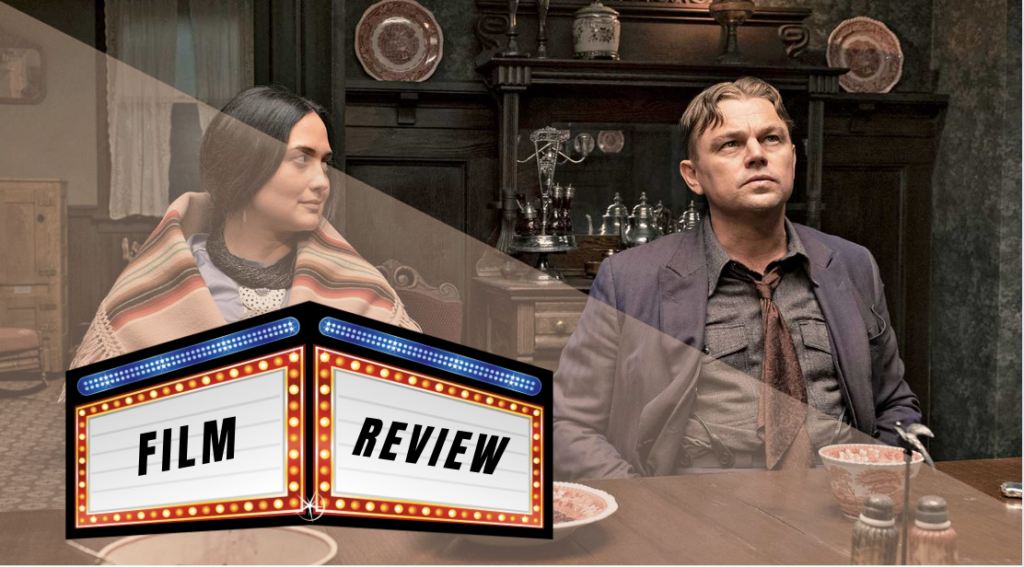
(Photo Manipulation by Nathan Rubin)
A booming oil town on Osage lands. The richest community per capita in the world. Twenty-seven confirmed murders.
This is the story Martin Scorsese’s latest film attempts to unravel. “Killers of the Flower Moon,” released Oct. 20 and based on the 2017 nonfiction book of the same name written by David Grann, follows the story of the Osage Murders Case that took place on the Gray Horse Indian Reservation in the 1920s. Focusing primarily on the family of Mollie Burkhart (Lily Gladstone), an Osage woman, the film explores the conspiracy of Mollie’s husband Ernest Burkhart (Leonardo DiCaprio) and Ernest’s uncle William Hale (Robert De Niro) to murder Mollie’s entire family in an effort to procure her vast oil estate.
Right off the bat, “Killers of the Flower Moon” is a well-made, provocative film. Scorsese is an accomplished filmmaker and storyteller, and the cinematography is fantastic. The many wide shots display the immensity of the grasslands surrounding the town, conveying a sense of isolation that contrasts with the richness and vibrancy of the film’s color palette.
In addition, the characters are complex. Ernest is an accomplice to William in a number of horrible murders while simultaneously claiming to love the wife whose family he has slowly been killing. The film leaves ambiguous the question of whether it was possible for Ernest to truly love his wife while committing these atrocities.
After reading the book, I was curious about how Scorsese would go about adapting this nuanced story. The film offers us an entirely different chronology from the book, framing the narrative primarily around Ernest, rather than FBI agent Tom White (Jesse Plemons).
We are introduced to Ernest as a bachelor returning from World War I, somewhat directionless but obviously greedy, which becomes clear to the audience through his refrain: “I love money.” By focusing the narrative on Ernest, Scorsese casts him as the most complex character of the film. He is simultaneously the victim of his uncle’s and his own greed and the victimizer of Mollie and her entire family. All this while claiming to love her.
Another diversion the film takes from the book’s narrative is the fact that this movie is not a whodunnit; we know from the beginning that Ernest and William are the ones committing these murders, and we see their perspective. Thus, it becomes a movie about the human relationships at play in the murder conspiracy, rather than a story about an influential early FBI case.
Because Scorsese is such a wonderful director, I was never in doubt that he would tell a compelling story, but I was weary of whose perspective he would choose to tell. The film is built around Ernest, but the crucial figure is Mollie. She is the one who loses her sisters, her mother and her friends. She is the one who Ernest betrays by poisoning her. While we do get moments of grief and complexity in her character, like when she releases a heart wrenching wail after the death of her sister, Rita Smith (Janae Collins), Mollie remains in the narrative’s background for the most part, becoming increasingly sick as a result of Ernest poisoning her. By depicting Mollie as stoic in her suffering, Scorsese casts the character as an eternal victim, powerless against Ernest and William.
This is not to say that showing the pain Mollie is going through isn’t important or that becoming overwhelmed with sadness and powerlessness is not a valid response, but it does flatten the character’s experience. It also shows a lack of imagination on Scorsese’s part, revealing his inability to show us Mollie’s complex relationships with her family and friends, unlike those with Ernest.
The only interaction we see between Mollie and her sisters is when they talk about Ernest. There are hints at various points that the relationship between Mollie and her sister Anna Brown (Cara Jade Myers) might be strained. Unfortunately Scorsese misses the opportunity to explore these fraught intrafamilial connections, instead focusing on the father-son dynamic of Ernest and William’s relationship. Not getting to see more of Mollie’s life outside of the pain they are causing her was disappointing.
Scorsese also chooses to end “Killers of the Flower Moon” in a strange way. The final scene is a beautiful aerial shot of a contemporary Osage ceremony, referring back to the opening shot of the film depicting an older ceremony mourning the loss of the tribe’s traditional ways as their children became more assimilated. This final shot is a nod to indigenous futurity, as it shows how the current Osage remain dedicated to their traditions and the continuation of those teachings.
This would have been a wonderful ending if not for the scene immediately before, where Scorsese chooses to depict the epilogue to the murders as a mid-century true crime radio show. The show has an eerily comedic tone and means that the people who survive the murders — people like Mollie or her children — do not tell the final acts of the story. In fact, Scorsese himself appears to give the final piece of information on Mollie by reading her obituary. While this was touching, and I could tell that Mollie’s story deeply affected Scorsese, the fact that Scorsese gets the last word felt like a final way to rob Mollie of her agency — she does not even get to say how the story ends.
Another crucial element of the book is the extent to which white intruders had systematically taken advantage of the Osage people. This exploitation was a result of the guardianship system imposed by the U.S. government after the discovery of oil on Osage lands.
As Grann detailed in his book, the Osage Murders Case happened in part because the U.S. government deemed the Osage Nation incapable of managing the oil money and required that individuals have guardians over their estates. Osage people did not necessarily have full control over the profits from the oil drilling, as they had to obtain permission to use that money from their white guardians.
This was a system inherently susceptible to abuse because it allowed people like William or Ernest to obtain control over Osage oil estates and headrights with extreme and unjust ease. Grann explained in his book how this kind of abuse was likely much more widespread than William’s crimes. This reality is hinted at in various points of the film but is not explicit in the way it should be considering how fundamental this fact is to the Osage Murders Case. Because the story focuses on the individual greed of William, Ernest and their accomplices, it fails to establish the racism, personal and systemic, that is elemental to retelling the history authentically.
“Killers of the Flower Moon” is a perfect film if you want to watch a film about greed consuming an evil man, but be warned that it does not portray the full story of the victims of that evil.
Bridget Mackie (she/her) (25C) is from Cary, North Carolina and majoring in English. Outside of the Wheel, Bridget likes to make art, knit sweaters and collect plants.






